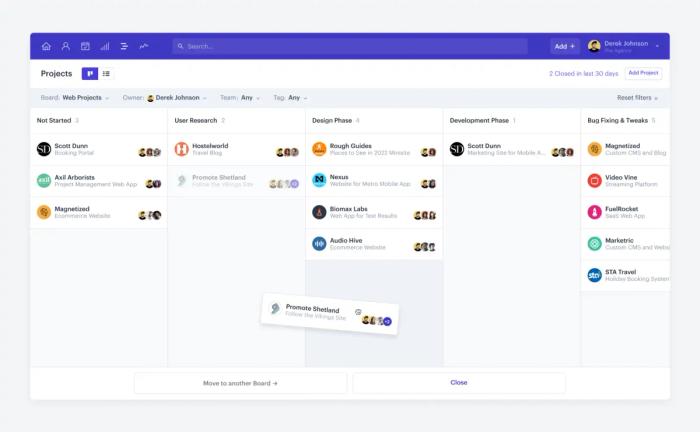Looking for the latest sales trend is like searching for a nail in a haystack made of screws – challenging and often elusive. Sales leaders often discuss popular sales models and benefits to them. Including whether it’s better to focus on inside or outside sales models, or maybe use both?
Are you now pondering something similar? You are in the right place. In this article, we’ll show you how inside and outside sales are similar, the key differences, and which of the two are the best fit for your own business.
What are inside sales?
Inside sales involve selling products or services remotely, usually by phone, email, or video conferences. Inside sales reps typically sell right from their offices or homes, rarely traveling to meet their customers face-to-face. Working remotely allows them to reach a broader customer base without having to travel, thus saving time and money.
Inside sales are especially common in industries with complex buying processes that require multiple interactions with customers.
Inside sales responsibilities
Inside sales reps have several responsibilities during their workdays. From identifying potential customers and interacting with them to encouraging conversion.
Let’s look at some of their daily tasks below.
- Lead generation: One of their main responsibilities is identifying potential customers (leads) and creating a database of prospects. For this task, they might use email or social media campaigns, to name just a few methods.
- Initial contact: Once they have a list of prospects ready, the next step is to make the first contact. This is typically done through cold calling, emailing, or messaging to introduce the product or service and gauge the lead's interest.
- Needs assessment: If the prospect shows interest in the offer, the sales reps can ask them a few more questions to understand the customer’s main needs, pain points and challenges. Active listening is a crucial skill here, as it can help inside reps determine how the product or service can solve the client’s problem.
- Product presentation: Next, the inside sales rep presents the product or service to the prospect, for example, via a product demo. They can also give the lead a detailed description of the product or service, emphasizing how it meets their needs.
- Follow up and nurture: Most leads won’t convert during the first contact, so the rep’s responsibilities also include maintaining contact through periodic follow ups.
- Closing the deal: Once the prospect is ready to make a purchase, the inside sales rep discusses the contract terms and payment methods. They then need to prepare the necessary documentation, and send it over in order to close the deal.
Examples of industries that often rely on inside sales
Software as a Service (SaaS)
SaaS companies often employ inside sales teams to sell subscriptions to businesses or individuals. Since the product or service they sell is digital, reps can easily show how it works via online demos or presentations. All the paperwork can be handled remotely too.
B2B wholesale
Businesses that sell their products in bulk often also use inside sales teams to manage large orders, negotiate deals, and maintain relationships with their B2B customers.
Online education
Inside sales is often the best method to reach potential customers for companies offering online courses or educational materials. Reps can explain the features, benefits, and pricing of various subscription plans or packages while keeping in touch with prospective students or educational institutions.
Medical equipment
The healthcare industry can use inside sales teams to sell medical devices and equipment. For example, reps can use video conferencing to demonstrate how the equipment works as well as its benefits, no matter its complexity.
Digital advertising services
Companies offering search engine optimization (SEO), pay-per-click, or other digital marketing services often use inside sales teams to find and contact potential clients. Reps can talk with prospects about their needs and goals online, while sharing any necessary data with the client (such as the SEO team’s work results) immediately, without waiting for in-person meetings.
What are outside sales?
Whereas inside sales mainly rely on calls and video meetings to talk with prospects, outside sales reps usually meet their potential clients face-to-face. Either at the client’s location or another agreed-upon venue. This approach is common in industries where the product or service being sold is complex, expensive, or requires a detailed and highly personalized explanation.

The focus here is on building long-term relationships with the clients and providing them a tailored service.
Outside sales responsibilities
As outside sales reps work differently than inside sales reps, their responsibilities are also dissimilar. Below are some of the outside sales reps' daily tasks.
- Territory management: An outside sales rep is responsible for a specific geographical area or location; scheduling meetings, visiting potential customers, and keeping in touch with existing ones.
- Client meetings: One of the core tasks is meeting (potential) clients in person, often at their chosen location. During such meetings, they discuss the customer’s needs and requirements, present the product or service, and answer any questions or doubts the prospect might have.
- Product demonstration: In industries with complex or high-value products, running an in-person demo to showcase the product and its main benefits might be necessary. That’s why outside sales reps are also responsible for scheduling demo meetings and then presenting them to potential customers.
- Proposal and quote creation: An outside sales rep is responsible for creating a formal proposal or quote outlining the pricing, terms, and conditions of the sale. This is created based on the client’s needs, as noted by the sales representative during a previous meeting.
- Contract negotiation: The sales rep is also responsible for handling any objections that the prospect might have and negotiating the contract terms, including price, delivery, and payment terms.
- Post-sale follow up: After the sale is complete, the rep checks in with the client every so often to ensure their satisfaction and identify opportunities for upselling or referrals.
Example of industries that often rely on inside sales
Real estate
Outside sales agents working for the real estate industry regularly schedule meetings with their clients for property viewings and contract negotiations.
Industrial equipment
A business that sells large industrial machinery may send outside sales representatives to factories or plants to show off the equipment’s capabilities and answer the prospect's questions.
Pharmacy
Outside sales reps in the pharmaceutical industry typically meet healthcare professionals or institution representatives in person to introduce new medications and highlight their benefits. They also often offer samples of the new product for healthcare professionals to try out.
Automotive sales
Outside sales are common in the automotive industry, especially for sales to other businesses rather than individual customers. For example, reps might visit car dealerships, rental agencies, or corporate clients to discuss vehicles, fleet purchases, or rentals. If you need help streamlining your automotive sales, explore Capsule’s CRM for auto dealers.
Consulting services
In industries like management consulting, outside sales professionals meet potential clients for in-depth discussions and assessments. Doing so allows them to learn more about the customer and provide them a more personalized service.
Inside sales vs. outside sales: similarities
Now that we have briefly outlined how inside and outside sales teams work and their primary responsibilities, let’s look at the similarities between both approaches.
Goal-oriented methods
Both inside and outside sales rep teams have goals and quotas to meet. Whether the goal is to increase market share, meet a quarterly revenue target, or launch a new product successfully, both kinds of sales professionals need to be aware of the metrics that define their success (or failure).
Besides metrics specific to their own responsibilities, sales reps also track more general key performance indicators (KPIs) like customer engagement, conversion rates, and average deal size.
Focus on relationship building
In both inside and outside sales, establishing and maintaining good relationships with prospects and customers is key. Inside sales teams may leverage digital communication channels like email, chat, or video conferencing to build rapport and better understand client needs.
On the other hand, outside sales professionals rely more on face-to-face meetings and site visits to offer a more personalized service.
The technology they use
While it might seem like inside sales teams need far more digital tools to handle their workload, outside sales is also pretty reliant on it. Both types of sales teams use customer relationship management (CRM) systems to track client interactions, manage leads, and analyze data for future strategies.
Outside sales reps are also increasingly using tablets or mobile apps for on-the-spot presentations, virtual product demos, and closing deals digitally when meeting clients in person.
Inside sales vs. outside sales: differences
As you can see, both types of sales teams’ goals and tools are very similar. But inside and outside sales teams also have a few key differences that you should consider when choosing which approach is a better fit for your business.
Location and travel
Inside sales professionals operate primarily from an office or a remote workspace, mainly relying on technology (phones or emails) to interact with their clients. On the other hand, outside sales reps spend a significant amount of time traveling to meet clients in person.
So if your business is focused on local customers and you want to offer a personalized experience to them, outside sales may be the better choice. If you have a product that you want to sell to a wider audience but without the costs associated with travel, inside sales are more appropriate.
Sales cycle length
Inside sales usually have a shorter sales cycle because transactions can be completed faster via phone or online channels, even if they need several touchpoints. Outside sales meanwhile typically have a longer cycle due to the time required for in-person meetings, presentations, and negotiations.
Level of personalization
Outside sales can offer a higher level of personalized service due to face-to-face interactions, which can be particularly important for complex or high-value products.
If, for example, you are a company selling specialized industrial machinery that can be tailored to each factory's needs, outside sales – for which reps can conduct on-site demonstrations – might be more beneficial.
Tools used in the inside vs. outside sales process

To handle their daily responsibilities as efficiently as possible, both inside and outside sales teams use several tools and platforms – from communication apps to research and data organization platforms. There are also a few dedicated apps that sales reps use depending on whether they work remotely or are spending most of their time traveling.
Let’s now take a closer look at the apps inside and outside sales teams often use.
Communication tools
Timely and effective communication between the rep and the prospect can make the difference between securing a deal and losing a potential client. That’s why both sales teams rely heavily on tools that ensure they remain connected, both with their clients and their teammates.
Crisp audio and clear video are especially important for inside teams since most of their communication is done online.

For outside sales, communication platforms are just as important though, as sometimes sales reps will need to set up an urgent remote meeting while on the go. Since they travel often, outside sales representatives also don’t have as much contact with their coworkers so communication tools come in handy.
Some of the tools sales reps might use for this task:
Organization tools
Sales rep’s days are filled with messages, meetings, and various tasks needed for the sales process to go smoothly. To be as productive as they can without getting overwhelmed by their responsibilities, representatives often use a dedicated project management platform and a CRM to keep their data in order.
Project management tools help both inside and outside sales teams to organize and keep track of their tasks. While a CRM makes it far easier to track all customer interactions and ensure that no potential opportunity is missed.

Most of these tools now have mobile versions as well, so outside sales reps can add or access information in their database during a meeting.
Some of the tools sales reps might use for this task:
- CRM such as Capsule
- Asana
- Todoist
- Google Calendar
- Trello (for organizing tasks)
- Microsoft OneNote
Navigation tools
For outside sales representatives, traveling is a part of the job description. Navigation tools ensure they can find the quickest route to their destination and get to their meetings on time without worrying about traffic jams or unexpected roadworks. Those tools can also help them scout convenient locations for client meetings and even find a good spot to grab coffee or lunch between meetings.
Some of the tools sales reps might use for this task:
Research tools
Sales is not just about pitching a product – it's about understanding the customer's pain points and giving them a solution to their problem. So before making that pitch, both sales representatives need to understand their potential clients — their challenges, market position, and main requirements. Previously, sales reps had to perform most of these tasks manually, which took a lot of time.

Now though, reps can rely on sophisticated research and analytics tools to getfar more data about their potential or existing customers than ever before, helping tailor pitches to each client’s specific needs.
Some of the tools sales reps might use for this task:
- Crunchbase
- Owler
- SimilarWeb
- SEMrush
- Ahrefs
- Analytical tools included in the chosen CRM platform
Presentation tools
A well-crafted pitch can capture a client’s interest, but an engaging presentation can seal the deal since visual content is much easier to digest. With presentation and visualization tools, salespeople can easily translate complex ideas into visual stories, making it easier for the client to understand how a given product might address their main issues and what they can gain from using it.
Some of the tools sales reps might use for this task:
Skills needed for inside vs. outside sales
Since their role and responsibilities are so different, inside and outside sales reps need to have different skills in order to be successful at their jobs. Following are some of the traits you should look for in your inside or outside sales candidates.
Skills needed for inside sales
- Technical proficiency: Inside sales reps often rely on a range of technology platforms to perform their duties, so they need to be comfortable with tools such as customer relationship management (CRM) systems, project management and presentation software, and analytical platforms.
- Quick thinking: Inside sales have shorter sales cycles, making it essential for reps to quickly assess a situation and make decisions based on the data they have at hand. This could be as simple as tailoring a sales pitch within minutes based on a client’s feedback or deciding on the best follow-up strategy for a lead.
- Concise but persuasive writing: Since most inside sales communication happens via email or chat, excellent written communication skills are essential. Being able to describe complex ideas with simple but persuasive language can make all the difference when it comes to encouraging new prospects to convert or keeping existing customers satisfied.
Skills needed for outside sales
- Networking: Knowing how to build and maintain a contact network is an essential skill for outside salespeople. This could involve attending industry events, engaging with potential clients during face-to-face meetings, or regularly following up to make sure that existing customers are satisfied.
- Presentation skills: Another critical skill for outside sales reps is experience with product demonstrations and creating compelling presentations. During the meeting, outside sales reps are expected to show the product or service they want to sell from its best side and tailor the solution to the prospect's needs. If the rep can present the product or service convincingly, that significantly increases their chances for closing the deal.
- Time management: Given the need to balance a variety of tasks (client meetings, travel, and administrative work) effective time management skills are crucial for outside sales professionals. Prioritizing tasks and optimizing travel routes, for instance, can help outside reps utilize their time more efficiently, improve their productivity, and increase sales as a result.
Universal skills needed for both positions
- Listening: Whether sales reps are engaging clients over the phone, via video conferencing, or in person, active listening skills are essential for their work. With them, sales professionals can better understand client needs, objections, and concerns to create more tailored offers for the client.
- Negotiation: Negotiation skills are just as critical as active listening. They allow sales reps to understand the client's needs better and create win-win solutions that serve both the customer and the company well.
- Product knowledge: Both inside and outside sales reps need to be experts on the product or service they are selling, as failing to answer a prospect's question or doubt might cause them to reject the offer. Being able to answer technical questions or deal with real-time objections shows the reps as professionals and put their prospects more at ease.
How Capsule CRM can help both inside and outside sales
A CRM is now virtually indispensable for both inside and outside sales teams, as it can make their job much more effective.

Capsule CRM might be exactly the tool your inside and/or outside sales teams need to become more organized, productive, and successful at their job. Benefits include:
- Keeping all data about their prospects and customers in one place, sales reps can prepare for meetings (both online and in-person) easily as they have everything they might need to create a compelling sales pitch.
- Workflow automation helps sales reps automate some of their more tedious tasks so they can instead spend time on their prospects.
- An integrated project management tool brings the team together by giving them a single place to manage sales, service, and support.
- For those who are always on the road, Capsule has a dedicated mobile app for both iOS and Android.
- Capsule CRM also has several integrations available, thanks to which your sales team can easily connect the apps they are using daily.
Want to see how Capsule works in practice? You can try our starter CRM with basic features for up to two users and 250 contacts first or contact our sales team to help you pick the perfect paid plan for your inside and outside salespeople.
Which sales method should sales leaders choose?
Outside sales may be a more suitable approach for companies that are not yet well known and need to aggressively acquire new clients through face-to-face interactions and on-site visits. This method allows for more personalized sales pitches and can be effective in building initial trust.
On the other hand, inside sales is often a better approach for established companies with a steady flow of inbound leads and a focus on upselling or cross-selling to existing customers. Inside sales can be more cost effective and scalable, making it ideal for businesses looking to expand their customer bases without significantly increasing overheads.
Can you merge inside and outside sales?
In some cases, a hybrid approach is ideal because it allows businesses to capitalize on the strengths of both methods. For example, Inside sales teams can handle the initial stages of customer engagement by leveraging technology to identify and connect with potential clients, then pass qualified leads to the outside sales team for in-depth, personalized interactions and demonstrations.
A hybrid approach could be particularly useful for companies with a diverse product line or customer base, as it allows them to adapt to the unique needs and preferences of different market segments.
Conclusion
So which sales model is better, outside or inside sales? Well, that all depends on your business needs, products or services, and the audience you are selling to.
If you want to build in-person relationships with your customers and give them highly personalized treatment, an outside sales model might be a good fit. If you have a product that can be sold online and the sales cycle is short, then an inside sales team may be the better choice.
Whichever sales model you choose, Capsule CRM is ready to help you enhance both your inside and outside sales strategy and efforts.




